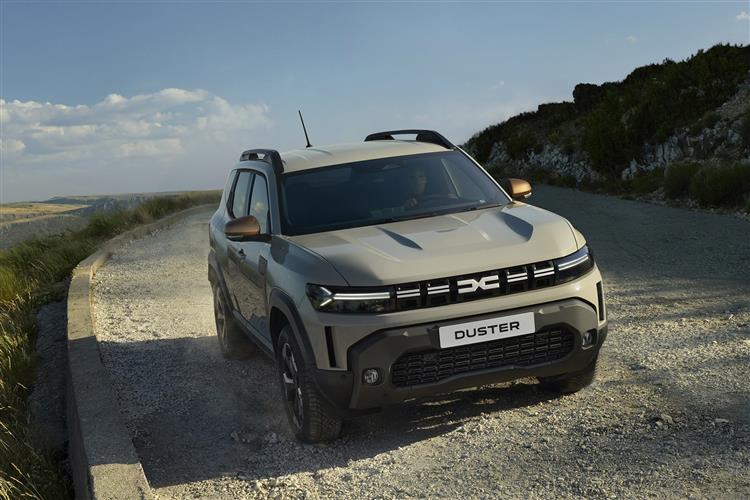DUST TO DUST (some text hidden) --NONE--
By Jonathan Crouch
Dacia's Duster resets value expectations for buyers of small SUVs in this third generation form. Jonathan Crouch drives it.
Ten Second Reviewword count: 42
The third generation version of Dacia's Duster is a much more advanced thing. But in many ways the spirit and value of its sensible, practical small SUV predecessors still remain. Don't buy another small, lifestyle SUV until you've looked at this one.
Backgroundword count: 209
'The best bargain on the market'. That's quite a claim isn't it, particularly for a car that starts from around £20,000. But this third generation version of Dacia's Duster SUV just might be. It's not an EV but it's the first Duster that's been in any way electrified and, thanks to use of existing Renault Group tech and cheap manufacturing in Romania and Morocco, it offers easily the best value compact family SUV proposition on the market. You could argue that the Duster always has, ever since it first arrived back in 2010. Alongside the Sandero hatch, it's been the brand's biggest seller since then, updated in second generation form in 2017 and along the way notching up 2.2 million registrations. All that's been founded on a back-to-basics approach to SUV design and a platform originally created by Renault in the '90s. A structure which of course couldn't accommodate the kind of electrified engines a car like this must now have. So this MK3 Duster adopts the same Renault Group CMF-B platform of other Dacias, a move additionally supposed to benefit practicality and refinement, though one that's also pushed the price up. But as we said earlier, the Romanian brand still thinks it's a bargain. Is it? Let's see.
Engines and Tech Specword count: 398
The range kicks off with a rarely-chosen TCe100 Bi-Fuel LPG model but the three engines that Dacia wants to talk about here are both more conventionally-fuelled electrified petrol units. One is a mild hybrid TCe 130 three cylinder powerplant that features a 48V system harvesting energy into a tiny 0.9kWh battery that uses it to aid acceleration. The other two options are self-charging Hybrids. There's the hybrid 140 powertrain already used by the brand in the Jogger (borrowed from the Renault Clio). This full Hybrid setup blends a 93bhp 1.6-litre four cylinder unit with a 48bhp electric motor energised by a 1.2kWh battery which can, Dacia claims, entirely drive the car for up to 80% of the time during urban motoring. If you need more power, there's the hybrid 155 version. This combines a 109bhp four cylinder petrol engine, two electric motors (a 50hp motor and a high-voltage starter/generator), a 1.4kWh battery (230V) and an automatic electric gearbox. It has four gears for the ICE engine and two for the electric motors. Unlike the auto-only hybrid 140 and 155 variants, the more affordable TCe 130 mild hybrid version offers manual or auto options; and can be had with 4WD as an option (the first time that the rear wheels have been driven on any Renault Group model fitted with this car's new CMF-B platform). This MK3 Duster has also been engineered for a simpler un-electrified TCe 100 engine, partly because Dacia wants to continue to offer the Bi-Fuel LPG system (hugely popular in Europe) that works with this unit. Of diesel power there is no sign; Dacia thinks 'diesel is dying' in this segment, so hasn't bothered with it. Which might be a disappointment to the significant proportion of customers likely to want the mild hybrid TCe 130 4WD version. This gets an evolved '4x4 Terrain Control transmission' system with five settings. Most of the time, you'll choose 'Auto', which distributes power between front and rear depending on traction and speed. There's also an 'Off-Road' setting that actively distributes torque between the axles. A rotary knob on the centre console also allows you to select either 'Snow', 'Mud/Sand' or 'Eco' options, plus in the middle of the dial there's a Hill Descent Control button to control your speed on slippery downhill slopes. Dacia claims approach and departure angles 31 and 36-degrees and up to 217mm of ground clearance.
To see the full road test text contact us on 0330 0020 227
Pictures (high res disabled)

.jpg)
|
.jpg)
|
.jpg)
| |||
.jpg)
|
Statistics (subset of data only)
Min |
Max |
|
Price: |
£19,380.00 (At 5 Sep 2025, Essential Tce 100 Bi-Fuel) |
£27,330.00 (At 5 Sep 2025, Extreme Hybrid 140) |
CO2 (g/km): |
147 (TCe100 Bi-Fuel) |
114 (Hybrid 140) |
Max Speed (mph): |
101 (TCe100 Bi-Fuel) |
105 (Hybrid 140) |
0-62 mph (s): |
14.1 (TCe100 Bi-Fuel) |
10.1 (Hybrid 140) |
Combined Mpg: |
43.4 (TCe100 Bi-Fuel) |
55.4 (Hybrid 140) |
Length (mm): |
4343 |
|
Width (mm): |
1810 |
|
Height (mm): |
1656 |
|
Boot Capacity (l): |
453 |
464 |
Power (ps): |
100 (TCe100 Bi-Fuel) |
140 (Hybrid 140) |



